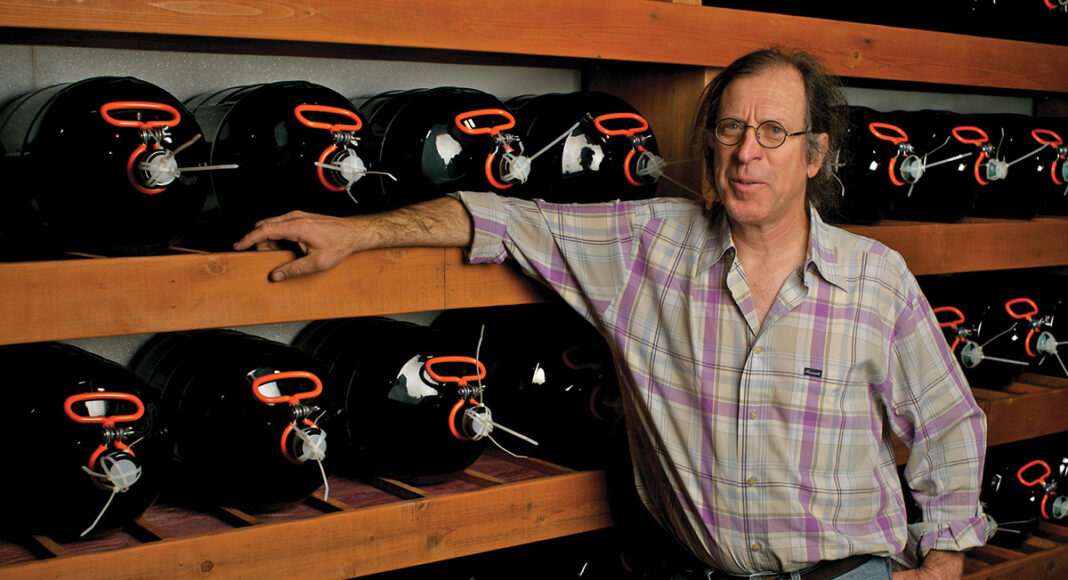Channel your inner David Bowie and chant along to “Changes” as you consider that after 35 years, there will not be a Randall Grahm as owner and president for life of Bonny Doon Vineyard. The brand was just bought by WarRoom Ventures LLC, a San Luis Obispo-based wine company that will handle management and marketing of a select group of Bonny Doon Vineyard wines.
Meanwhile, Nicole Walsh, who just opened an Aptos tasting room for her own brand Ser, will continue to oversee winemaking. Grahm might step back into Bonny Doon Vineyard’s cellar from time to time as a consultant, but we’ll see. It is the perfect time for something new for the Rhône Ranger after so many years of tinkering, finessing, creating, schlepping, selling, pouring, and all that involves—and it is a bittersweet end to one of the colorful sagas in Santa Cruz oenological mythology.
bonnydoonvineyard.com.
Winding Down?
Meanwhile, according to Silicon Valley Bank’s annual State of the Wine Industry report, overall wine sales by volume in the U.S. are down for the first time in 25 years. Millennials aren’t drinking as much expensive wine, and boomers are getting messages about health concerns and wine consumption. So I checked in with some of the people in our local wine world to see what their tea leaves indicate
Alexia Moore wine rep Robert Marsh: “Boomers, who carried the ball for decades, are consuming less for health reasons and/or retiring with less money to spend on premium wine,” Marsh says. “Three decades ago, you could drink wine from the great producers of France and California at reasonable prices. Being able to buy those types of wines at reasonable prices vis-a-vis your income was not a choice between homelessness and a bottle of wine. It is now.” Marsh believes wine “is a casualty of the current high cost of living.” Also, there are now many craft beer and cider producers that did not exist for boomers, along with “vast amounts of bourbon, rum and vodka.” Plus, there’s legal weed to appeal to younger consumers. “But declining California wine consumption could change for domestic producers if the Trump wine tariffs come into play,” Marsh says.
Alex Krause of Birichino: Krause acknowledges that we’re in “a fiercely competitive marketplace. In order to succeed, one has to have the right wine for a given market, and the ability to present it in a way that stands out and resonates with buyers and ultimately consumers.” Birichino is small and “very lean, with just John [Locke] and myself and one part-time employee, so it’s possible for us to be very efficient with our production costs,” Krause says, adding that Birichino’s sales are growing. “We just had our best year ever, and have a strong millennial consumer following.”
Jordan Iverson of Vinocruz: “Craft brewing of both beer and wine has shot up significantly over the past decade,” Iverson says. “Locally, we have seen both the beer and wine industry thriving yet facing increases in pricing due to costs [of items] such as hops and barrels shooting up. California property costs are making it very difficult for new wineries to even get into the game. Additionally, the alcohol percentage of beer has increased significantly, so when you look at bang for the buck in terms of getting a buzz, I feel like the economics sometimes comes into play for a younger audience, which may account for a shift toward beer.”
Jim and Judy Schultze of Windy Oaks Estate: “Boomers are drinking less wine as they age. We’ve even noticed that in our own consumption,” the winemakers admit. “We don’t think it’s lack of finances, at least not with our wine club. We see very positive trends with millennials, and many of our new members are in this category. People tend to forget that the wine industry is cyclical, like our economy. Several strong years of production have resulted in an excess of bulk wine—we saw this a few years ago in Europe, particularly with vast pools of bulk wine in Bordeaux.”
I’ll continue exploring this trend in future columns, but clearly marketing matters, as does knowing your target consumer. And, yes, libation choices have increased exponentially.













